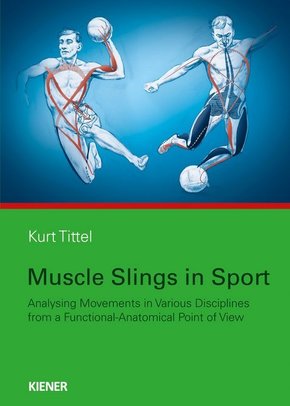
Muscle Slings in Sport - Analysing Movements in Various Disciplines from a Functional-Anatomical Point of View
| Verlag | Kiener |
| Auflage | 2015 |
| Seiten | 152 |
| Format | 20,2 x 27,6 x 1,2 cm |
| Gewicht | 602 g |
| Artikeltyp | Englisches Buch |
| ISBN-10 | 3943324419 |
| EAN | 9783943324419 |
| Bestell-Nr | 94332441A |
In this book the author describes sequences of movements in sport, and illustrates how the muscles, which are united in concerted actions, combined with their connective tissue sheaths (fascia), work together in functional groups known as "muscle slings". This term has been introduced and widely applied in the theory and practice of sport and sports medicine. The author paints a vivid picture of the phases of the various movements in sport, and points out the muscles which are involved in muscle slings - just as if he were an enthusiastic reporter watching a game or an athletic performance. He describes in detail the muscle slings involved in the following sport disciplines (among others):throwing (javelin, medicine-ball, shot-putting)wrestling and boxinggymnastics (parallel bars, rings)rhythmic gymnasticsrowingballet dancingjumping (high, long, hurdling)running (sprinting, race-walking, short-distanceclimbingfootballThe text is superbly complemented by the unique three-part illus trations created in the 1950s by the Leipzig artist, Kurt Opitz. Their quality and accuracy have never been bettered - and probably never will be - because they are the result of an intensive cooperation over a lengthy period, between the artist and the anatomist.
Inhaltsverzeichnis:
1 Analysis of sequencesof movements in sport from a functional-anatomical point of view11.1 Adaptability of the motor system as a process and outcome 21.2 Form, structure and function 31.3 Open and closed joint systems41.4 The cooperation between muscle groups which form muscle slings 71.5 Coordinated capabilities - functions and the basis for "motor learning" 91.6 Functional principles for sequences of movements 101.7 What should be considered with regard to muscular imbalance 121.8 Learning to observe and describe 152 Applied anatomy in sport172.1 Extensor slings of the lower extremity 19Anatomy revisited: The central role of the spinal column in dynamic and static sequences of movements 222.2 Extensor slings in whole-body movements 30Overextension of the body backwards 30Long- and middle-distance runners 32Sprinter (at the start of the 100 meters) 36Javelin thrower 40Medicine-ball thrower 42Wrestler (standing combat) 44Wrestler (ground combat) 46Boxer 48Gymnast 50Rower 52Anatom y revisited: Lesion-prone weak point: lumbo-sacral transition 56Weightlifter 59Inhibitory and braking function of the extensor sling 622.3 Flexor slings of the lower extremity 64Basic movements64Sudden and brisk lifting of the leg 66Ballet dancer 68Hurdler 702.4 Flexor and extensor slings in whole-body movements 70Long jumper 72High jumper 76Rope climber 78Wall climber 78Anatomy revisited: Muscles of the trunk and the shoulder girdle in artistic gymnastics 802.5 Muscle slings in static sequences of movements 84Gymnast on parallel bars 84Gymnast on the rings 86High-bar gymnast 92Anatomy revisited: Role and integration of the abdominal muscles in lateral inclination and rotation 942.6 Muscle slings in lateral inclination and rotation of the body 98Lateral inclincation of the trunk 100Rhythmic gymnastics 104Gymnastics with round weights 107Anatomy revisited: The central role of the knee joint in many sports disciplines 108Football player (crossing the ball) 112Football player (volley ing the ball) 114Handball player (jump shot) 116Discus thrower 118Javelin thrower 120Hammer thrower 1222.7 Combination of muscle slings 124Shot-putter 124Race-walker 126Short-distance runner 128Final Remarks 1303 Appendix 131Afterword 132Source of figures and tables 133References 133Index 136
